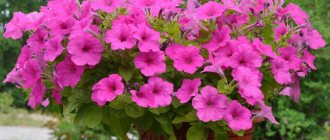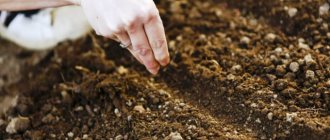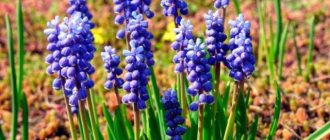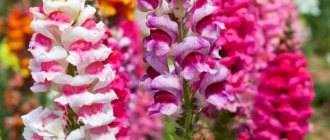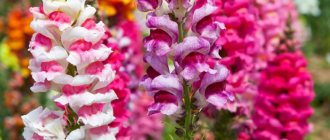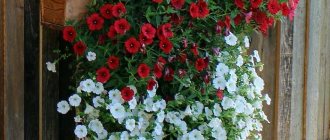Petunias always remain at the peak of popularity, as they bloom for a very long time and vigorously. But even among them there are varieties and hybrids that can especially surprise with their beauty. Of course, a lot depends on the care, but still the main parameter is the varietal characteristics. Ampelous petunias create a real waterfall of flowers, so hanging flowerpots, pergolas and cascading flower beds can turn any yard or cottage into a real fairy tale. We offer 7 beautiful varieties that will attract looks all summer long.
Tango Blue Star
A hybrid that blooms with very large flowers. They form quickly; few early varieties can compare with Tango Blue Star in this parameter. At the same time, the variety is very unpretentious: it tolerates a lack of moisture, wind and damp periods. The only requirement is to grow it in a well-lit area, otherwise the buds will not form so quickly and vigorously.
In addition to decorating balconies, gazebos and hanging flowerpots, this petunia is used for carpet plantings, since a dense network of shoots entwines everything around.
Variety of frillitunias
Frillitunia varieties differ only in color and there are not so many of them. Given the growing demand for these hybrids, their range will certainly be replenished with each season.
On sale you can find:
- snow-white frillitunium variety “Snowflake F1”;
- bright pink, the most popular variety “Butterfly F1”;
- soft pink frillitunia “Aphrodite pink F1”;
- dark pink variety “Crinoline pink F1”;
- dark red “Crinoline red F1”;
- an unusual variety with a muted lilac-violet color and an almost black throat “Express ruby”,
- unique red wine variety “Burgundy F1”;
- deep purple, velvety variety 'Carnival F1';
- dark purple-violet, speckled "Brazilian Carnival F1".
Depending on the conditions and even the characteristics of the seeds themselves, the color of flowers in certain varieties may be heterogeneous, with white streaks or “strokes”. Sometimes there are variety mixtures on sale - white and pink “Inspiration”, white and red “Daiquiri”, etc.
Opera Supreme
A relatively young variety bred in Japan. One of the important characteristics is the absence of such a limiting factor as daylight hours. This makes it easier to grow seedlings and even allows you to use petunia in winter gardens and greenhouses.
It has very long shoots - up to 1 m, and when grown in hanging flowerpots - up to 1.2 m. Moreover, the branches are densely covered with shoots. The shape of the flowers is simple, but the buds develop until frost.
Related article:
What are the names of flowers that look like onions?
How to choose a hanging container?
A flowerpot is a vessel in which a flower pot is placed ; it has a largely decorative function, while the pot has a utilitarian function.
Initially, flowerpots were intended to hide nondescript clay pots to add decorativeness to a room or setting. Thus, the flowerpot serves as a tray, but increasingly, plants are planted directly in the flowerpot without using a pot. On the modern market, flower pots are presented in a wide variety of materials, designs, and colors. So how do you choose? First of all, one should proceed from a practical point of view. If we are talking about ampelous petunia, then it is mainly planted on verandas, gazebos, balconies, around the house, that is, open areas and rooms. Therefore, it is necessary to choose a material that will not deteriorate from rain, wind and sun. In this case, plastic, ceramics and metal are suitable.
Hanging pots are most suitable for hanging petunias. Here are some popular varieties :
- Flowerpot on a metal chain with a cocovita liner.
- Plant pots made of plastic with imitation rattan.
- A simple plastic planter.
- Flowerpots with fastenings for balconies and hedges.
The advantages of hanging flower pots include the following characteristics::
- save horizontal space;
- can be placed where there is no support;
- high mobility, for example, during frosts you can easily bring it into a warm room.
Also similar in their characteristics to hanging ones are wall vases, which can perfectly decorate the walls of your gazebo or terrace.
An interesting type of flowerpot is in the form of a floor vase, in which hanging plants will fall in a beautiful waterfall all the way to the ground. Such a vase can be made of plastic or ceramic.
You can build a tall vase from several larger, flatter vases; if you place one on top of the other, then your garden will have a kind of fountain of flowers.
Otherwise, when choosing a flowerpot, a gardener should be guided by his taste preferences and the general style of the house , so that the flowerpots are combined with each other and with the surrounding environment, then the flowers will decorate the space and look harmonious.
Parple Velvet
A bright variety of petunia that has been proven over years of cultivation. The size of the hanging lashes reaches 1 m. The petals have an intense purple coloring. The cascade formed by this variety is smooth and dense.
To achieve maximum bush size, it is necessary to use fertilizers. Without the application of complex mineral fertilizers, Parple Velvet risks remaining an inconspicuous plant, but with systematic fertilizers it will reveal its full potential.
For flower beds
Not only bush petunias are suitable for placement in flowerbeds and flower gardens. The cascading form of the plant looks impressive, when long shoots evenly cover the ground, forming a multi-colored carpet.
A popular variety of petunia for decorating a flower bed is multi-flowered. The shoots of the plant can grow up to 35-50 cm, forming a lush spherical bush. There are so many buds opening on the plant that sometimes the foliage is not visible.
Varieties and hybrids:
Ferrari - bush height up to 20 cm, width up to 50 cm, flowers 6-8 cm in diameter, scarlet, do not lose their decorative effect from rain and wind.
Califfo (hybrid) - velvet flowers up to 6 cm in diameter, colors: blue, red, burgundy, cherry, all flowers with a white border around the edge.
Elegy - the dimensions of the bush are 25 by 60 cm, the branches are simple, 7 cm in diameter, painted in a light purple hue, with a lightened neck.
Califfo
Elegy
Star (mixture of shades) - petunia, up to 30 cm high, flowers up to 8 cm in diameter, bud color - a contrasting combination of white with red, pink, purple.
Jolly is a bush petunia with lush blooms of white, blue, scarlet, and pink flowers.
Sophistry Blackberry - bush height 40 cm, flowering abundantly, until frost, the color of medium-sized flowers is burgundy-black, the structure of the petals is velvety.
Jolly
Blackbury Sophistry
Star
Ramblin'
One of the important advantages is the uniformity of flowering times. This allows you to put the bush in the foreground at the moment of greatest decorativeness and remove it further at the moment of gaining strength. A dense ball of vegetative parts is formed, bald spots do not appear. At the same time, the variety is resistant to other fungal diseases, despite the density of the foliage. Professionals note the excellent germination of Ramblin seeds, which is very important, given the fairly high price of planting material of this variety.
Caring for a blooming crop
It is important to promptly remove faded buds. If this is not done, the plant will lose strength. It will not be able to form new flowers. As for pruning the bush, this is not required. The culture itself has a dense and neat shape.
If the grower still wants to change the plant, you can safely trim it: the culture calmly reacts to such manipulations.
Reproduction
Since the crop is a hybrid, it cannot produce viable seeds on its own. Therefore, propagation material can only be obtained in a store where it comes from breeding organizations. In order for the landing to be successful, a number of actions must be performed:
- take a shallow container;
- pour light soil into it;
- pour with warm clean water;
- spread the seeds on top of the soil, maintaining a distance of about 4 cm (there is no need to cover them with soil);
- cover the plantings with glass or film (you can also use agrofibre, which will better maintain optimal humidity);
- place the container in a well-lit place (in some cases additional lighting may be required);
- ensure the temperature is about 20-22 degrees.
Sowing of seed material begins in early February. The latest date for such an event is the beginning of March. Shoots can usually be seen after 10-14 days. Frillitunia needs full daylight. If natural light is not enough for 13-14 hours, it is worth using additional sources.
These are phytolamps or fluorescent devices. Lighting devices are placed at a distance of about 10 cm from young plants.
Watering should be done very carefully. A good solution would be to use a medical syringe. Gently moisten the soil under each plant using the drip method. You cannot spray seedlings. When 2 leaves are formed, the young flowers dive. Since the culture is tender, double picking is carried out.
First, the plants are placed in cassettes or boxes. After some time, they are moved to separate containers. Seedlings are planted in May or early June (when the threat of frost has passed). The distance between flowers should be at least 20 cm.
The growing process is accompanied by the treatment of seedlings with special means to improve growth and development. Usually "Kornevin" and "Fitosporin" are used.
Avalanche Purple Star
The variety got its name for its 5 bright purple strokes on a white base, which resemble the rays of a star. At the first stages of growth, the shoots are erect, but as their length increases, they begin to droop and turn into hanging forms.
It is important that even in bright sun the colors of the stripes do not fade. For this reason, the bush looks fresh and well-groomed throughout the season. At the same time, Avalanche Purple Star is not afraid of pruning even in adulthood and quickly restores the shape of the crown.
Use in ornamental gardening
In order to achieve such impressive flower sizes, breeders had to sacrifice a considerable number of practical properties of petunias. Including durability. Even compared to the most common garden petunias, frillitunias are more sensitive to adverse weather and precipitation.
These flyers are afraid of rain and strong winds, getting wet, and any unprotected place. And this significantly limits the possibilities of their use in garden design.
Frillitunia is planted in open soil only on flower beds-islands on terraces or under canopies. She is unusually effective in borders, but her instability does not allow her to reveal all her talents. Otherwise, this annual plant is used as a container plant. And in potted culture, it will truly become the most striking of the petunias on your site.
Frillitunias cannot be used as ampels in the corners of the house, in places where the roof does not reliably protect the plants from the vagaries of the weather. Frillitunias seem to be created for verandas and terraces, gazebos, and protected recreation areas.
True, such restrictions also have their exceptions.
While you are in the garden, containers with frillitunias can be placed even in the most open areas, taken out to flower beds, paths, and used in decorative compositions. In order to protect the plant, you will need to remove the containers in a timely manner in bad weather, but as a temporary, portable decoration, they are inimitable.
Aladdin Grandiflora
Typically, ampelous varieties have small or medium-sized inflorescences, so not everyone will be able to recognize the ampelous variety in the Aladdin Grandiflora petunia. However, this is exactly it, it’s just that its flowers reach a size of 15 cm, which makes it unusually beautiful.
Related article:
Diseases and pests of asters
The variety is an early flowering variety, so the first buds are formed within a few weeks after germination. At the same time, Aladdin Grandiflora does not need such careful formation of the bush as other hanging varieties.
How is it different from petunia?
As already mentioned, frillitunia is a hybrid. In other words, it is a large-flowered petunia. This hybrid is distinguished from the basic varieties of the crop by the peculiar “ruffles” of the petals and the special tenderness of the plant. Unlike petunias, the crop is more sensitive to bad weather conditions.
Due to strong gusts of wind, openwork flowers can lose their beauty. Plants don't like rain either. Thin petals tear, become sluggish and lifeless.
The best solution would be to grow flowers in places protected from bad weather. For example, it could be a veranda, gazebo or balcony. This way you can enjoy lush flowering without worrying about the health and preservation of the decorative appearance of the plants. As for the color of the flowers, frillitunia does not differ from other species.
The same palette of pink, purple and red shades of petunias is presented here. There are also snow-white flowers that are loved by many.
Potunia Plus Papaya
This variety grows a huge number of side shoots, which leads to the appearance of a regular, beautiful shape. Petunia does not require the use of growth regulators, so it is often chosen by those who deal with these flowers professionally.
Potunia Plus Papaya tolerates spring cold snaps and summer heat well. Such extreme conditions do not affect flowering. The branches are resistant to strong winds.
Cascade
These petunias are very similar to hanging petunias, but there are significant differences between them. They must be taken into account when choosing a place to plant flowers in the garden. Cascading petunias have shorter shoots and are not as thin and flexible as ampel petunias. Immediately after germination, the stems grow upward, and then, as they lengthen, they begin to droop under their own weight, but the tips still tend upward.
The Typhoon variety blooms very profusely and is disease resistant. Flowers reach 8–9 cm in diameter.
The Ramblin F1 neon rose variety is highly valued for its unpretentiousness and lush flowering. The bush begins to produce buds already from the fourth leaf, gradually forming a three-dimensional cascade of large and bright flowers.
The Gioconda variety adapts perfectly to any latitude. The diameter of the flowers is 5–6 cm. The pot for this petunia should have a volume of at least 10 liters.
The Ramblin F1 variety has a bright color and a persistent pleasant smell. The diameter of the flowers is 7–8 cm.
Recent Entries
Chainsaw or electric saw - what to choose for the garden? 4 mistakes when growing tomatoes in pots that almost all housewives make Secrets of growing seedlings from the Japanese, who are very sensitive to the soil
The Ramblin Burgundy chrome variety is distinguished by early flowering and disease resistance.
A distinctive feature of the Cascade F1 Snow White variety is its large double flowers. Their diameter is as much as 12 cm. Petunia blooms for a long time - from April to August.
Petunia Orchid mist blooms very profusely. The diameter of the buds is up to 9 cm. The plant is resistant to fungus and cold.
The Typhoon F1 red velor variety is distinguished by a huge number of small (3–4 cm in diameter) buds. The bush is very bright and blooms for a long time.
The Tornado F1 silver variety blooms from May to August, without losing its splendor. Petunia is unpretentious, its flowers are 4–5 cm in diameter.
The Bicolor cabernet variety surprises with its rapid growth and very abundant flowering. The buds are two-colored, 6–7 cm in diameter.
The differences between the Burgundy variety are its unpretentiousness and lush flowering. There are a lot of buds on the bush, their diameter is up to 5 cm.
The Table White variety blooms all summer, the bush is very lush and exudes a pleasant aroma that intensifies in the evening.
Petunias Million Bells live up to the name of the variety. It seems that a million bells of a burgundy-scarlet hue are scattered throughout the bush. The variety is unpretentious to the conditions, but propagates only by cuttings.
The Sky Blue variety is very bright and blooms luxuriantly. The diameter of the buds is only 3–4 cm, but there are a lot of them on the bush, so that the effect of a flower avalanche is created.
Classification of the new most beautiful and best species according to basic characteristics
Petunia acquired its name more than 120 years ago.
It was first discovered and named by Indian tribes in the Amazon River basin. It was thanks to the efforts of this people that two flowers were isolated from 40 species of wild plants, which became the progenitors of a huge number of petunia hybrids. At the dawn of its decorative glory, the plant lived in southern countries, preferring warm and sunny areas of the territory. But through selection, varieties were developed that easily adapted to the more severe climatic conditions of life in the northern regions.
Reference! Long-lasting and less demanding petunias have slightly smaller inflorescences. This variety includes, for example, the Bravo series, as well as Polo and Hurray from the actively flowering multiflora group.
It is not possible to create an unambiguous and clearly structured classification of petunias. But a simplified version of systematization can come to the aid of an inexperienced florist, who gets in the way of the complexity of nomenclature. It looks like this:
- According to the appearance of the bush:
- ampelous;
- cascade;
- bush.
- According to the nature of flowering and the diameter of the buds:
- grandiflora;
- floribunda;
- milliflora;
- multiflora.
- According to the structure of the buds:
- simple;
- terry.
This classification makes it possible to classify the plant into several species groups at once.
Individual varieties are distinguished by growth vigor and type of shoots. Their diversity can also be classified according to:
- color scheme;
- bud size;
- jagged edges of petals;
- the presence of veins, white stripes and a lightened center.
Some petunias have a powerful aroma, while others have a less intense scent. Next, you can read the names, characteristics, descriptions and see photos of different beautiful types of petunias.
After flowering
If you want to save the flower, you need to remove it from the ground in October, and remove all the branches from the bush. The shrub is moved to a container in a cool place. It will need to be watered occasionally to keep the soil moist enough. When the month of February arrives, the plant is moved to a windowsill that is well lit by the sun. It must be warm there.
Petunia grandiflora
Now you will need to water it more often. When 2-4 pairs of leaves are formed, the plant is cut off at the “heel” and moved to a flowerpot. They must be filled with soil with nutritional properties, and a layer of sand placed on top of it.
The container is also covered with film or glass is placed and moved to a place where there is moderate shade. For 20 days you will need to water, ventilate and spray the sprout. By this time the shoots should have taken root. Afterwards I transplant them into cups. They are transferred to open ground at the same time as the seedlings are transplanted.
In the fall, faded bushes that are no longer needed should be removed from the ground and burned. After this, the soil must be dug up.
Diseases and pests
| Blackleg Ways to fight:
| |
| Gray rot Ways to fight:
| |
| Aphid Ways to fight:
|
Reviews from gardeners
Frodo, Tolyatti
You buy the very first petunia, then plant it at home in a large pot and place it on the window, feed it, and after two weeks you have not one plant, but 10, and in the house it grows 20 times faster than outside, the main thing is that there is light .
Source: forum.tvoysad.ru
Lobelia, Zhukovsky
There were good results when feeding AVA for balcony flowers. Petunia loves to eat, but potassium-phosphorus “food”.
Source: www.forumhouse.ru
Suitable for landscape design
The different types and characteristics of petunia allow you to decorate your garden in any style.
Photo: apg.land Petunia hybrid - photo, description of the species:
- Hybrid petunia (lat. Petunia x hybrida) - belongs to the Solanaceae family. Obtained by crossing two species, axillary and purple petunia. It is a herbaceous green plant with creeping or erect stems. The leaves and stems are covered with glandular hairs. Flowers are formed from axillary leaves.
- The plant blooms all summer and easily tolerates light frosts. The flowers are funnel-shaped, beautiful, and there are double forms. The colors and sizes of flowers are very different. Pollinated by butterflies. In our climate zone it is grown as an annual plant.
- The types of petunias are very diverse : multi-flowered, cascading, large-flowered, excellent. They differ not only in the size of the flowers, but also in the shape, as well as in their abundant flowering. There are specimens with fringed and smooth edges, with many petals and multi-colored colors.
- The flower is grown in sunny places protected from the wind. With a lack of light, flowering becomes scarce, the flowers become smaller, and the color fades. Petunia can be planted both in open ground and in pots, all kinds of hanging pots, and flowerpots.
Creeping petunia has long stems and short growth.
Photo: floral-house.ru The author of the video recommends forming petunia bushes from the very beginning of development. As soon as side shoots form from the rosette, they should be cut off, 7–10 cm long. Pruning is done by leaving 2 - 3 leaves on the shoot, the rest is cut off. Flowers can be propagated from cut shoots:
New, unusual varieties
More and more new varieties are appearing in the assortment of flowerbed and balcony varieties that deserve special attention. The main emphasis of breeders is on the uncharacteristic color of petunias.
Attention! Currently, new hybrids have received the greatest attention from flower growers, the distinctive feature of which is “black” flowers.
Taking into account the latest trends, the following varieties have gained wide popularity:
- "velvet";
- "cherry".
Velvet
Cherry
